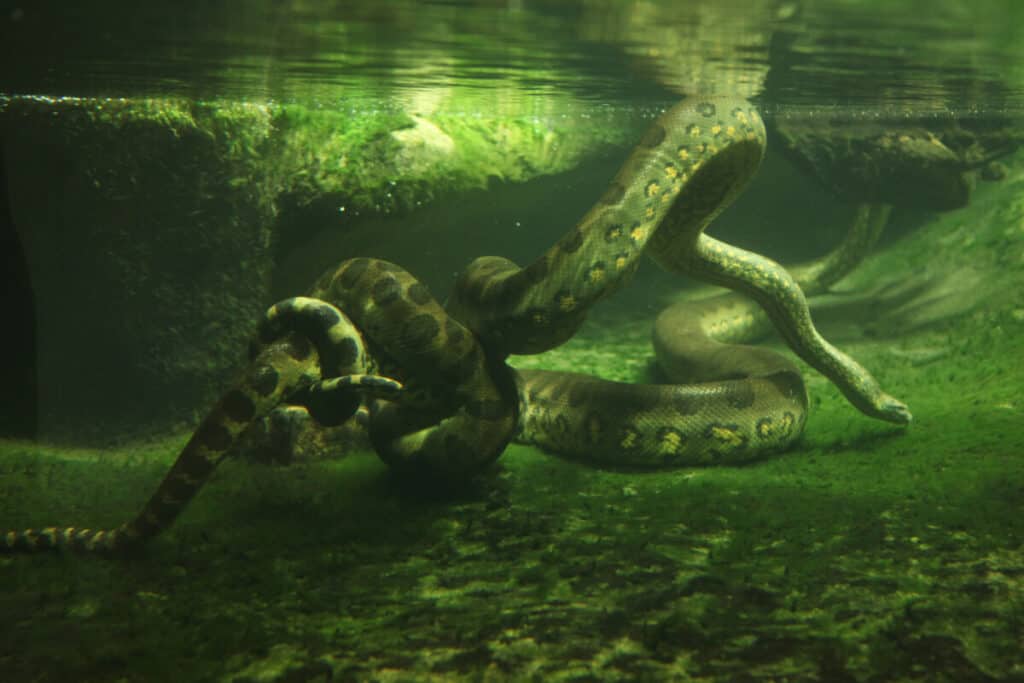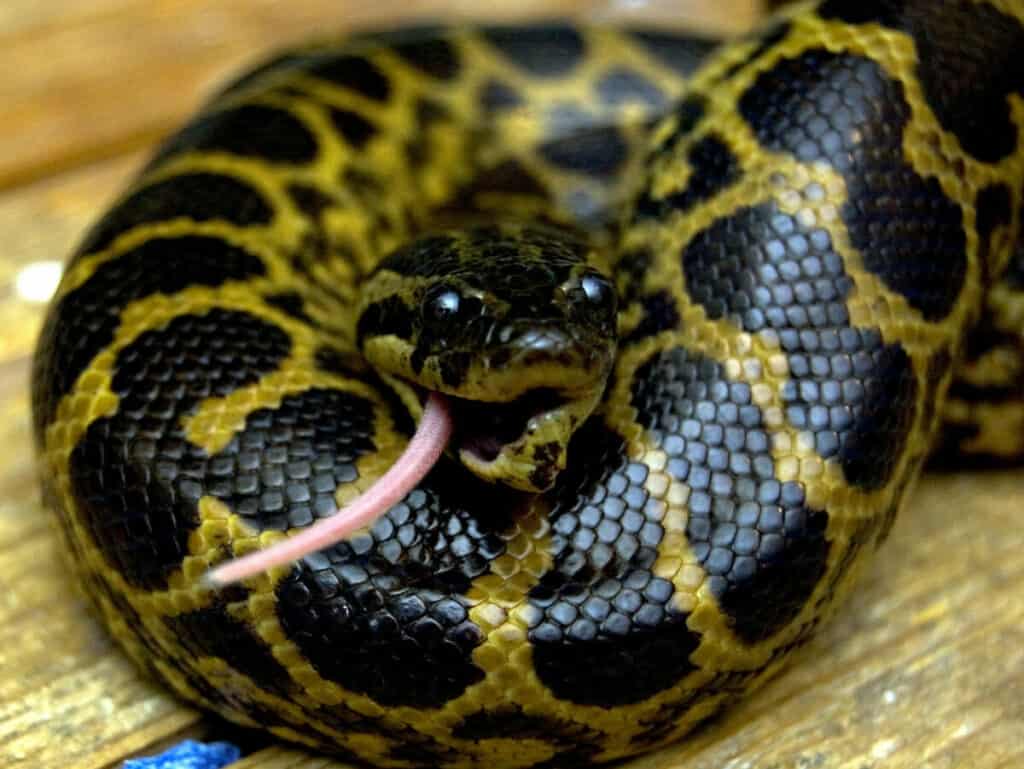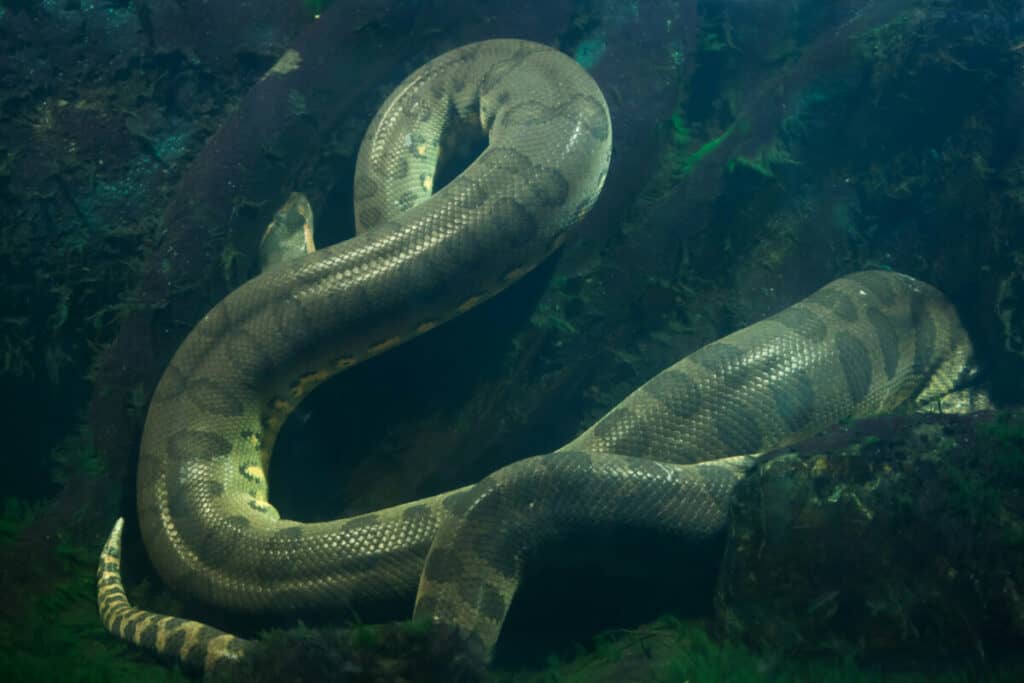
Anacondas are fascinating snakes, but what do they eat? Many people know that anacondas are not herbivores, especially because it is hard to imagine such a large snake snacking on plants and leaves rather than animals.
Anacondas eat rodents, lizards, fish, capybaras, jaguars, bird eggs, deer, caimans, large birds, and sometimes male anacondas. Anacondas kill their prey by restricting their breathing by wrapping around them and tightening their muscles, biting them, or dragging them underwater.
To find out more about what anacondas eat, how often they eat, and whether or not they can eat humans like you, keep reading.
What Do Anacondas Eat?
Anacondas eat many animals. They are not picky snakes and often attack and eat animals that are bigger than them. Large anacondas sometimes eat jaguars and large deer, even though jaguars are considered one of the anaconda’s only predators.
So basically large anacondas might prey on smaller jaguars and large jaguars might prey on smaller anacondas. That said, jaguars on not one of the more common items on the menu for an anaconda.
What Anacondas Eat
- Rats
- Rabbits
- Fish
- Turtles
- Caimans
- Capybaras
- Jaguars
- Deer
- Tegu
- Iguanas
- Large birds
- Bird Eggs
- Wild Pigs
- Sheep
- Dogs
- Tapirs
- Peccaries
- Male Anacondas
Anacondas Are Carnivores
Anacondas are carnivores and generally eat whatever is available as long as they can catch it and expect that they won’t be injured while doing so. However, that doesn’t mean that they avoid eating predators; they can eat jaguars and even though they can harm anacondas.
Smaller anacondas typically tend to eat smaller animals like rodents, birds, and fish. Only larger anacondas will eat large prey because they are confident that they can overpower the animal and digest it over time.
Anacondas use their teeth, strength, and environment to kill their prey. Anacondas like pythons are nonvenomous, so they can’t use venom to disable their prey. Instead, they kill their prey by strangling, drowning, and biting them.
Their teeth are very sharp and anacondas are extremely fast, so they can disable their prey with a single bite and it is hard for prey to run away from anacondas. They are also extremely strong and are essentially a rope made of muscle, so it is easy for them to strangle their prey.
Anacondas can also break the spines of their prey so they die nearly immediately. Anacondas use their environment to their advantage, so they drown their prey if they can’t subdue them in other ways. Their teeth and strength come in handy while drowning prey, as they can drag it into the water and keep it there.
Anacondas Love To Hunt and Eat At Night
Anacondas are nocturnal, so they typically hunt at night. The darkness of night paired with their natural camouflage make it nearly impossible for prey to see them as they approach.
Anacondas don’t chew their food. Instead, they swallow it whole. They have large mouths that can open extremely wide and their skin is extremely stretchy, allowing prey to slowly glide down their gullet and accommodate the size of larger prey. Their muscles also help move their meals along.
If you have seen an anaconda after it has eaten a meal, you have likely seen a lump in the middle of its body. This is its meal, as it hasn’t been broken down yet by the snake’s stomach acid. It takes a while for an anaconda’s meal to completely break down.

Can Anacondas Eat Humans?
Anacondas can eat humans, but they typically don’t bother. Even though many people think that if an anaconda sees a human, it will overpower it and eat it, anacondas typically run away from humans when they encounter them. This might be in contrast to what you see in the movies.
However, that doesn’t mean an anaconda won’t attack you if it feels threatened. It just means that they likely won’t eat you, which can be comforting. Either way don’t go anywhere near an anaconda in the wild. It’s not really worth finding out whether or not you would be on the menu.
After all anacondas are capable of eating humans, it just that they typically don’t. Anacondas, especially large females, are big enough to eat humans, especially because they often eat similarly-sized animals. Because of this anacondas are often killed by humans. Thankfully, however, anacondas are not currently considered an endangered species.
Do Female Anacondas Eat Males after Mating?
Female anacondas sometimes eat male anacondas after they mate. This is likely because female anacondas don’t hunt while they are pregnant, so they don’t eat. Hunting while pregnant, as they keep their eggs inside of their bodies for a few months before they are ready to hatch, poses a risk to the eggs, so they simply don’t do it. However, this means that female anacondas have to eat more than normal and eat at every opportunity.
Fully-grown female anacondas are much larger than male anacondas, which means they can eat them and sometimes do. Because of this, male anacondas have to be wary while mating. If they suspect that the female anaconda is no longer interested in them and is instead looking for a snack, they get out of the situation as soon as possible. This type of behavior is not limited to one species of anaconda.
Female anacondas are pregnant for about 7 months at a time, which is a long time to go without eating. Female anacondas eat more than normal during the breeding season, and when they are done mating, it is logical that they would see the male snake that they just mated with that is much smaller than them to be a good source of calories and fat for the female, which is likely why they eat them.
It is simply a matter of survival for anacondas, even though we may think it is horrifying for a female to eat their mate. However, that doesn’t mean that female anacondas eat their mate every time. It simply can happen, so anaconda breeders and owners need to be aware of the possibility when breeding their anaconda.
How Often Do Anacondas Eat?
Anacondas eat between every few days to every few months. How often they eat varies depending on the size of their last meal and how big they are. A large anaconda doesn’t have to eat often unless they are female and it is breeding season. Small, young anacondas have to eat every few days while they grow. They can’t eat extremely large meals because of their size, so they have to eat more often.
Anacondas typically have slow metabolisms, which allows them to go a long time without eating. If an anaconda is hungry or suspects that it won’t be able to hunt anytime soon, it will eat when it sees prey. However, anacondas can go up to a few years without eating, especially if they don’t move very much. The more dormant an anaconda is, the fewer calories they burn, and the less they have to eat.
Anacondas kept in captivity typically eat 1-2 times every month, but their meals are regulated. Anacondas in captivity are not often fed large animals like deer and capybaras. Instead, they are fed rats, rabbits, or even pigs.
What Are The Different Types Of Anaconda

There are four different types of anaconda: the dark-spotted anaconda, yellow anaconda, Beni or Bolivian anaconda, and green anaconda. The green anaconda is the type of anaconda that people typically think of when they think about anacondas.
The dark-spotted anaconda typically grows to be 9 feet long and has brown or back spots on its skin. The rest of its skin is often brown, which helps it blend in with its environment.
Bolivian anacondas are relatively unknown, but they look similar to green anacondas. Scientists used to think they were a hybrid species of yellow and green anacondas, but they have since learned that that is not the case.
More is being discovered about this type of anaconda every year, but one of the reasons why so little is known about them is that they are relatively hard to find or recognize, especially because of how similar they look to green anacondas.
Yellow anacondas are bright yellow, tan, or yellow-green and have black or brown spots or streaks on their back, belly, and the end of their tail.
Green anacondas are bright green, greenish-brown, greenish-gray, or olive in color and have brown or black spots on their back. Green anacondas are the most well-known species of anaconda and are the longest snakes in the world, as they can grow to be up to 30 feet long and 12 inches in diameter.
Anaconda Diet Based On Environment
Anacondas often live in slow-moving bodies of water like rivers, flooded grasslands, and streams. Anacondas thrive in water because their eyes and noses are on the top of their heads, so they can breathe and see while their body is underwater. They also burrow under sand or mud to hide and avoid predators. However, they also often live in trees or hidden amongst vegetation so often found in their habitats.
Anacondas don’t have many predators, especially large female anacondas, but that doesn’t mean that small, young anacondas don’t have to worry about them. If a jaguar comes across a young anaconda, it will likely attack it, especially because large anacondas sometimes eat jaguars, so jaguars see anacondas as threats.
Anacondas are nocturnal, so they are awake and hunt at night rather than during the day. They typically live in warm climates, where water is abundant, vegetation is thick, and prey is abundant. They live in warm climates because they are cold-blooded creatures.
Overall, anacondas have a variety of animals that make up their diet. They can eat fish, but they often don’t because of how hard it is to catch them. Have you ever had to hold onto a fish while it is in water? It is nearly impossible, even when you have the long fangs of an anaconda. Fish are also extremely fast swimmers, which makes them hard to catch.
Anacondas are interesting creatures, especially because there is so much variety between the different species’ when it comes to how long they grow. The diets of anacondas don’t typically change depending on the species, especially because anacondas can eat so many different things. Their diet mainly changes depending on their environment and what is available when they are hungry.
